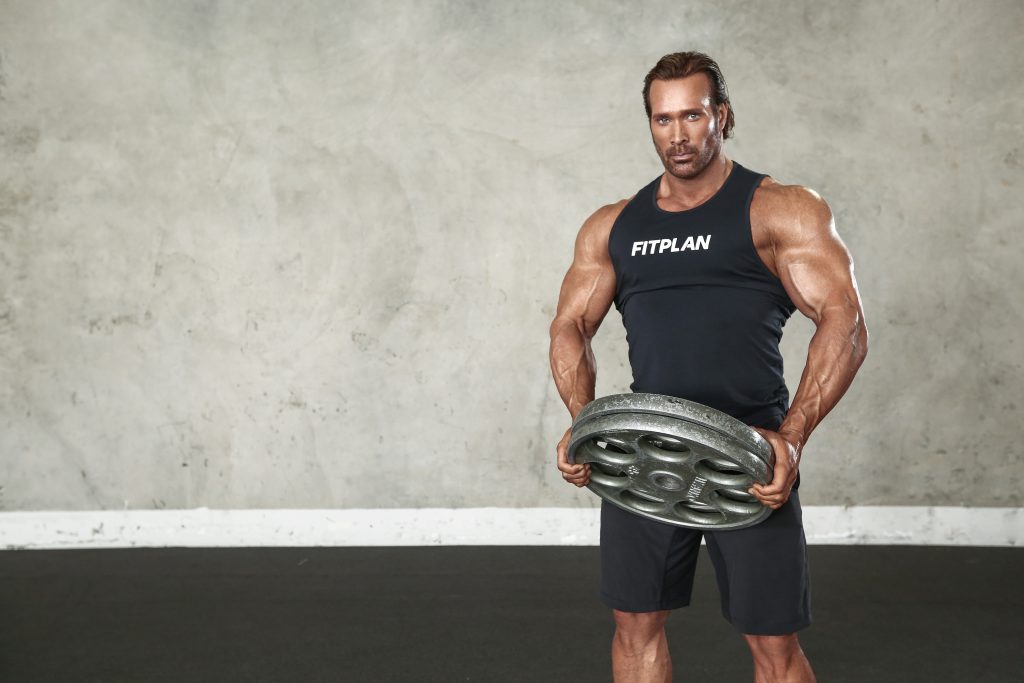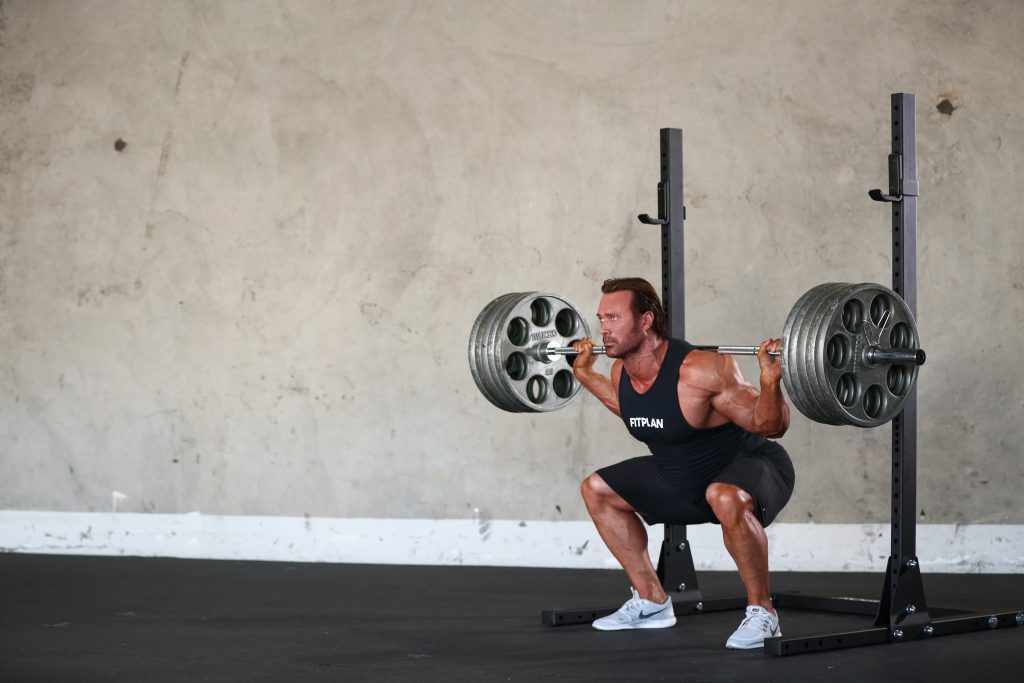Strength training has just as many benefits for 40-year-olds and over as it does for people in their 20s and 30s. Muscle mass does tend to naturally decline once we turn 30, but you can stave off the worst effects of this loss with a regular training program that keeps your muscles strong and even growing.
Other issues like past injuries and joint pain may affect what kinds of exercises you can do or the intensity of the exercise, but nothing is stopping the over-40 crowd from engaging in regular strength training based on their age alone.
Whether you’ve been working out for decades or you’re building a fitness plan for the first time, it’s never too late to get in shape. Use the strength training tips in this guide to build a workout program that will build muscle no matter what age you are.
(Note: Want our elite trainers to help you build a personalized workout routine? Start your Fitplan free trial today!)
Sarcopenia & Aging
For many people, one of the most discouraging things about fitness past a certain is sarcopenia, which is the name given to the loss of muscle mass and function that mostly afflicts older adults. While it is true that many people begin to lose power and mass in their muscles as they get older, that doesn’t mean we’re all doomed to become frail.
Researchers divide sarcopenia and frailty because not everyone who experiences muscle loss as they get older reaches a state where they aren’t able to do normal tasks. One study reveals that 5 – 13% of elderly people are affected by sarcopenia on average.
This estimate clearly shows that natural muscle loss should by no means prevent people from exercising to build muscle strength.
How Much Muscle Do You Lose With Age?
It’s a bit surprising, but this muscle loss doesn’t kick in during middle age. Beginning around age 30, humans can lose as much as 3 – 5% of their muscle mass per decade. Diet and levels of hormones like testosterone both affect the severity of this natural muscle loss.
Your personal history also affects how much muscle you lose. For example, if you’ve been working out for decades and then stop, your body will start cutting muscle mass. That loss could compound with natural loss and you could see more loss.
Generally speaking, though, physical activity causes your body to build more muscle and should prepare you well for any muscle loss as you age. The best thing you can do to maintain muscle mass is to keep working out so that your body will continue building muscle mass.
Best Workouts for Building Muscle Mass Past 40
Some exercises are great at building muscle but they don’t challenge your body in ways that cause it to build true body strength. That strength is key to maintaining muscle mass over time. Speed, intensity, and agility are all incredibly important for muscle growth and protection against muscle loss.
Helpful Hint: Improve your strength, speed, and agility with our Viking Strength & Function Fitplan!
Focus on variations of popular exercises that require unique changes in direction. If you can, include plyometric movements or organize high-intensity interval (HIIT) training sessions to push your body as much as possible. A fair amount of cardio is great for your overall wellness and helps your body build muscle.

10 Golden Rules for Strength Training Over 40
Building muscle mass is a huge challenge no matter how old you are, but lifters past 40 have some unique difficulties to face. Follow these 10 golden rules to make sure your strength training workout routine suits your needs.
1. Use Progressive Resistance Training (PRT)
No matter your experience level, a PRT program is the best way to preserve your muscle mass. PRT operates on a logic common to many bodybuilders: when your muscles are larger and stronger, increase the difficulty of the workout by adding more weight, reps, or sets.
Avoid magical cure-alls like testosterone supplements. The best thing you can do to build strength is to keep your muscles busy. Your body gets used to whatever strain you put upon it, which is why you have to up the ante consistently.
PRT builds muscle strength and helps improve the body’s performance generally. One study found it lead to reduced pain in participants with osteoarthritis. It might sound scary, but muscle exhaustion is a great way to build strength in the body’s various muscle groups.
If you organize the exercises in your PRT routine, you can completely wear out your muscles so they gain as much strength as possible. More intense workouts with rest days are an effective way to build muscle and strength, but you can also do more reps more frequently at a lower intensity and see considerable health benefits.
2. Spare Your Joints
Even if you don’t have arthritis, working out the wrong way can cause painful injuries to the critical joints of your body. Not only is this stressful on its own, but a severe injury could prevent you from continuing your weight training routine.
Classic bodybuilding exercises such as the bench press might be great for building strength in your core and upper body, but they also take a toll on important joints. Filling your training plan with different exercises like the shoulder press is a good way to prevent shoulder joint injuries or painful conditions like rotator cuff tendinitis. In general, bodyweight exercises put less pressure on your joints.
For a really good workout, add a resistance band to your bodyweight exercise routine. Banded exercises keep your muscles activated throughout the entire exercise rather than only in certain sections like traditional weight-training moves do.
3. Focus on Functional Strength
Chiseled abs and huge biceps have their aesthetic appeal, but for older people achieving sculpted muscles is often more difficult because of the way muscle tissue changes with aging. That’s why it’s more important to engage in exercises that build the kind of strength your body needs to accomplish daily tasks like walking, jumping, carrying weight, and using the stairs. To build the best functional strength, use exercises that mimic daily activity.
The Stairmaster is a great exercise machine for building useful strength. If you do stair-climbing exercises with the proper form, you can spare your knees some pain and reduce the likelihood of knee injuries in the future.
Exercises with multiple components for building balance and gait as well as overall strength are the best for more functional strength. Simple exercises like glute bridges, push-ups, and squats are great for a warm-up or newcomers to fitness. Single-leg Romanian deadlifts, front squats, and full-body workouts like deadlifts are some of the best for more experienced lifters.
Helpful Hint: Build more functional strength with our CMC Fit Fitplan!

4. Beware of Overtraining
Exhaustion after a hard workout is one thing, but sustained exhaustion and short rest periods that don’t afford your body enough time to recover can have incredibly negative effects on your mental health and prevent you from continuing with your workout routine.
The signs of overtraining are fairly obvious. Unusual and sustained muscle soreness during or after a workout is one sign. Delayed recovery and the inability to complete exercises are also common in people who have overtrained.
General fatigue frequently accompanies overtraining. For people who have been exercising for years, continuing at the same pace when your muscle mass has decreased can lead to an overworked body.
Listen to your body. The most important thing is coordinating the self-image in your mind with the real abilities and limitations of your muscles. Don’t forget to take days off for your body to recover after workouts and drink plenty of water to increase hypertrophy.
5. Keep Your Exercises Varied
Just as you should keep your rep range changing to keep your body from getting used to the exercise, it’s also important to target different muscle groups throughout your workout routine. Don’t forget your lower body and smaller stabilizing muscles in your core and glutes.
Balance weight lifting exercises with leg presses and lunges so important muscle groups in your lower body like the hamstrings, quads, and glutes can also get a workout. Full-body workouts like deadlifts involve muscle groups throughout your body and also build muscle in your upper body.
The back and core are two other areas that lifters tend to only exercise incidentally while targeting other muscles. Increasing your pull-up count and targeting large muscles like your latissimus dorsi with exercises like lat pulldowns are a great way to get a broad back and strong shoulders.
6. High Reps Are Key
As we age, our single-lift max and ability to lift more weight may reduce. For older people who are losing muscle mass, high reps are the best way to make up for a reduction in maximum strength. It’s more effective to lift less weight more times and you’ll feel much more effective during your workout as well.
With the right exercises, you can keep your heart rate up for longer periods with more reps even when you use less weight. Maintaining a good heart rate without putting the heart under too much pressure will make it operate even better and lead to better cardiovascular health overall.
You might have to build up to higher rep counts if you’re new to regular exercise or spent more time trying to deadlift more weight rather than building endurance. Lifting heavier weight with fewer reps has its place in the routine as well. You should be doing twice or three times as many high-rep exercises as heavy lifting ones.
When you hit your goal rep count, stop the exercise. Sometimes we get pumped up on our success and push past the goal we set for ourselves. That’s not guaranteed to doom you, but it can lead to injury if you aren’t careful about it.
If you’re really doing well at our strength training, get through the whole routine and then add another set of an exercise of your choice. In any case, it will always be better to improve at a good pace over time than to crame additional work into your workout routines without planning for it.
7. Embrace Exercise Variations
If you haven’t already been using different variations of classic moves like dumbbell rows and squats, you should add them to your strength training routine. Not only do they keep your body from adjusting to the traditional versions of these exercises, but they also move your body in different ways and activate muscles that otherwise aren’t targeted.
For example, Bulgarian split squats are a single-leg variation of the squat that give your leg muscles a much more complicated workout. You can also change the position of your feet during leg presses to target your quads or glutes more.
Using variations doesn’t mean you have to leave the traditional moves out of your workout routine completely. Just don’t forget to balance your routine to make sure you don’t exhaust muscles too early. When you do single-leg or arm exercises, remember to work out each side of your body so you develop the same amount of strength and muscle everywhere.
Helpful Hint: Shred body fat and get a full-body workout with our second Strong & Lean Fitplan!
8. Mind Your Spine
The joints aren’t the only part of your body you should be careful with when you’re strength training. Lifting weights also takes a toll on your spine. To prevent painful injury, make sure you don’t overload your back with weights.
That doesn’t necessarily mean you have to lift less weight. Just be mindful that you shouldn’t be loading huge amounts of weight onto your lower back and spine every time you go workout.
A great way to manage this is to pack all your spine-loading exercises into one day of the week so that your spine has plenty of time to recover for the next time. Sit-ups and back extensions are two great examples of exercises that load weight on your spine. Protracted periods of unusual posture can cause the tissue to go away and lead to injury.
The good news is that, provided you do the right exercises, building muscle and strength around your spine makes it stronger. Strength training can even relieve back pain if it’s done correctly.

9. Train Outside the Gym, Too
If you want to build strength in your body, you should be active as often as possible, even when you aren’t working out. Simple adjustments like taking the stairs and going for after-dinner walks can help you get as many as 10,000 steps a day and keep away pesky fat.
Walking and getting fresh air do wonders for your health on their own. If your main goal is to maintain muscle mass, consider isometric exercises and simple banded varieties of exercises that will build strength without wearing your muscles out completely. If you spend lots of time sitting, add some movement the break up the long periods of inactivity.
Simple warm-up moves like jumping jacks, planks, step-ups, squats, and pull-ups allow you to exercise just about anywhere at a moment’s notice with nothing more than your own bodyweight. Push-ups, crunches, and all their variations are also fantastic for spur-of-the-moment exercise.
If you want to engage in exercise that more closely mimics strength training, you should invest in some dumbbells, a kettlebell, or a barbell. With one of these weights and a bench, you can bring most of your strength training regime home or even do a pared-down version on breaks at work.
10. Set Up for Success
All the naysaying about sarcopenia and muscle loss as people age might paint a pessimistic picture. If you give your body what it needs and push it to create muscle with adequate recovery time to do so, you can stave off the worst effects of reduced muscle mass past the age of 40.
Don’t forget that diet and sleep play huge roles in this process as well. Balance your macronutrients and make sure you’re getting 7 – 8 hours of good sleep each night. Doing so will leave you better prepared for strength training when you need to be and give your body the building blocks it needs to build muscle and maintain it.
Warm-up more than you think you need to and always aim for perfect form. There’s always room for improvement when it comes to exercise form, especially on the more complicated maneuvers.
If you feel any kind of pain while you’re working out beyond slight muscle soreness from exhaustion, don’t try to push through it. That’s the fastest way to get an injury when you’re strength training and you’ll definitely regret it if you allow your larger fitness goals to be squandered because of an avoidable injury.
Helpful Hint: Learn how to shred fat from one of the pros with our A-Rod Fit Fitplan!
Conclusion:
Although the loss of muscle mass is a natural consequence of aging, that doesn’t mean you have to resign yourself to becoming sedentary and incapable of daily tasks. The best thing you can do for yourself is to engage in regular strength training. If you aren’t doing so already, it’s never too late.
There are certain things that will be more apparent for the over-40 crowd. Protecting joints and the spine is essential, as is warming up properly and changing up your routine to keep your body from adjusting to the exercise. As long as you take your own fitness level and personal history into account, there’s no reason why you shouldn’t be able to use strength training to maintain and build muscle and reduce the risk of injury.
(Note: Want our celebrity trainers to help you get into shape? Start your Fitplan free trial today!)


